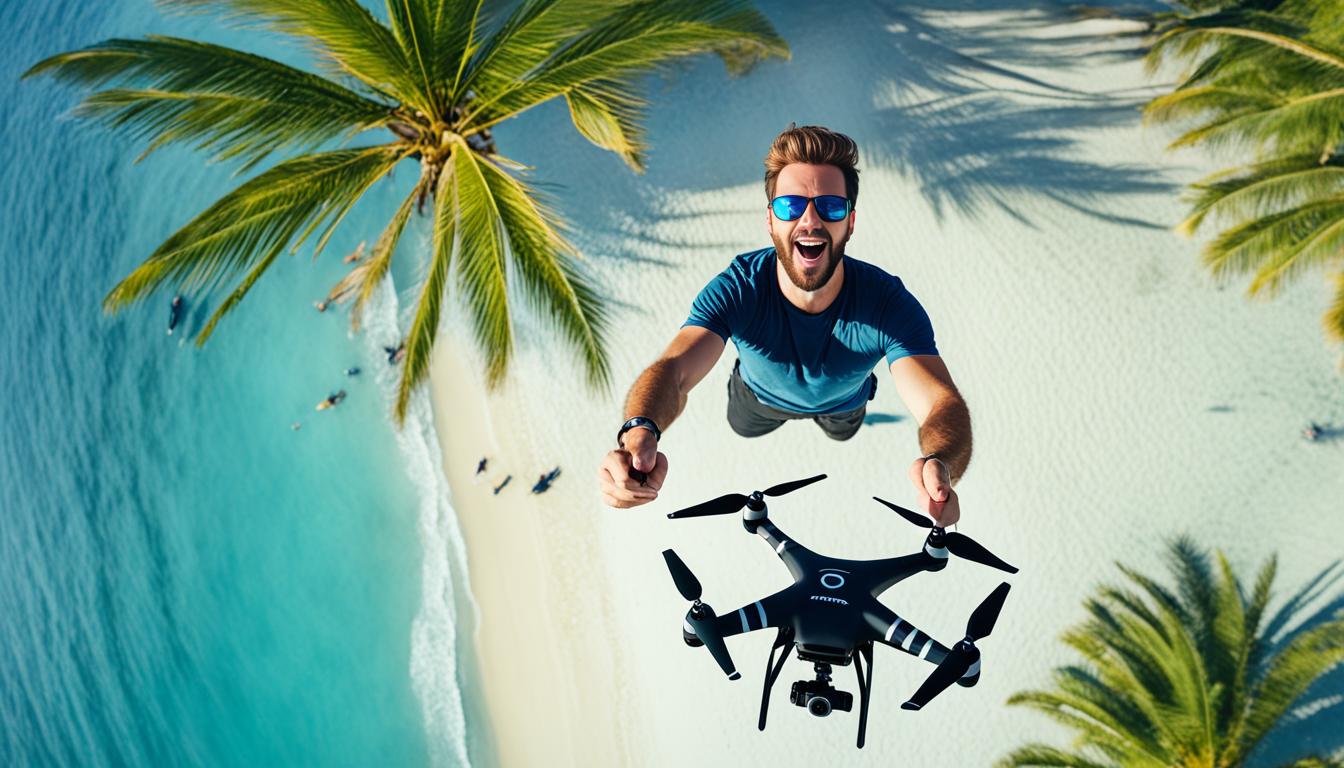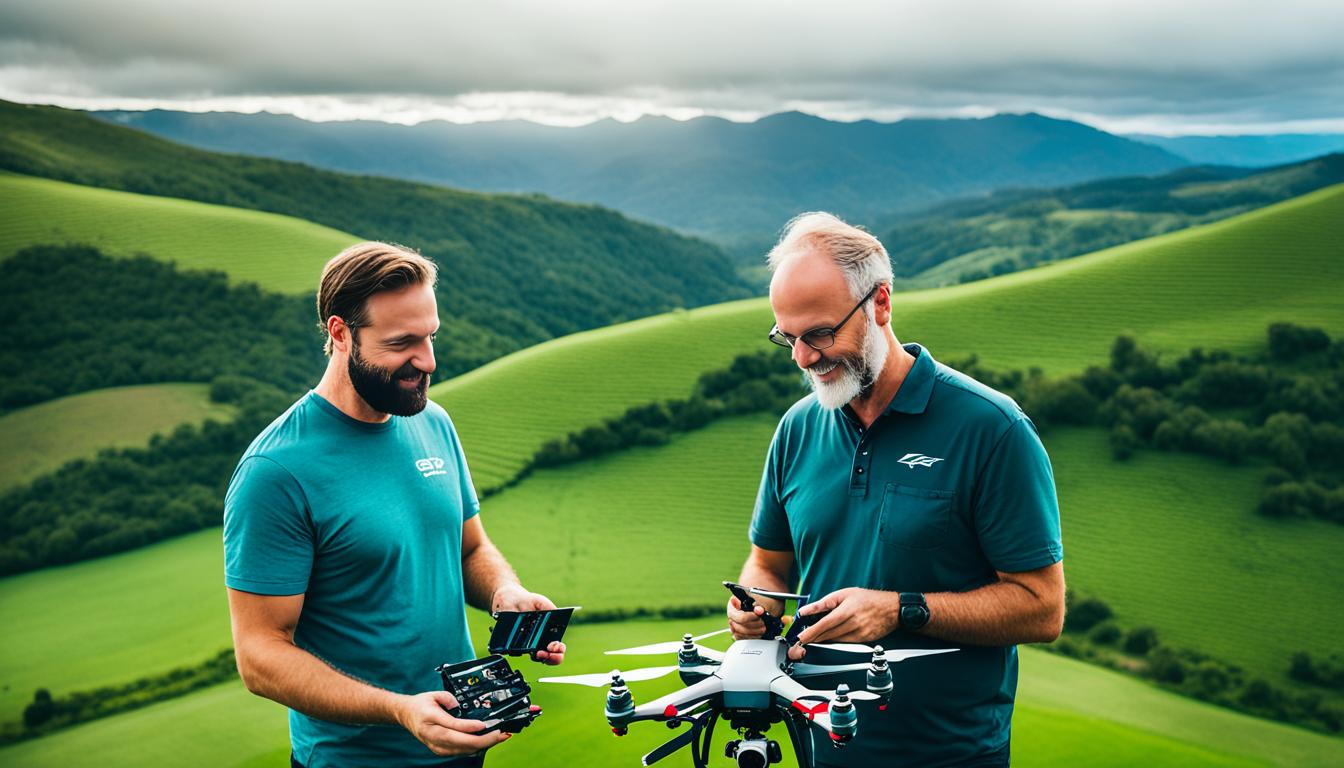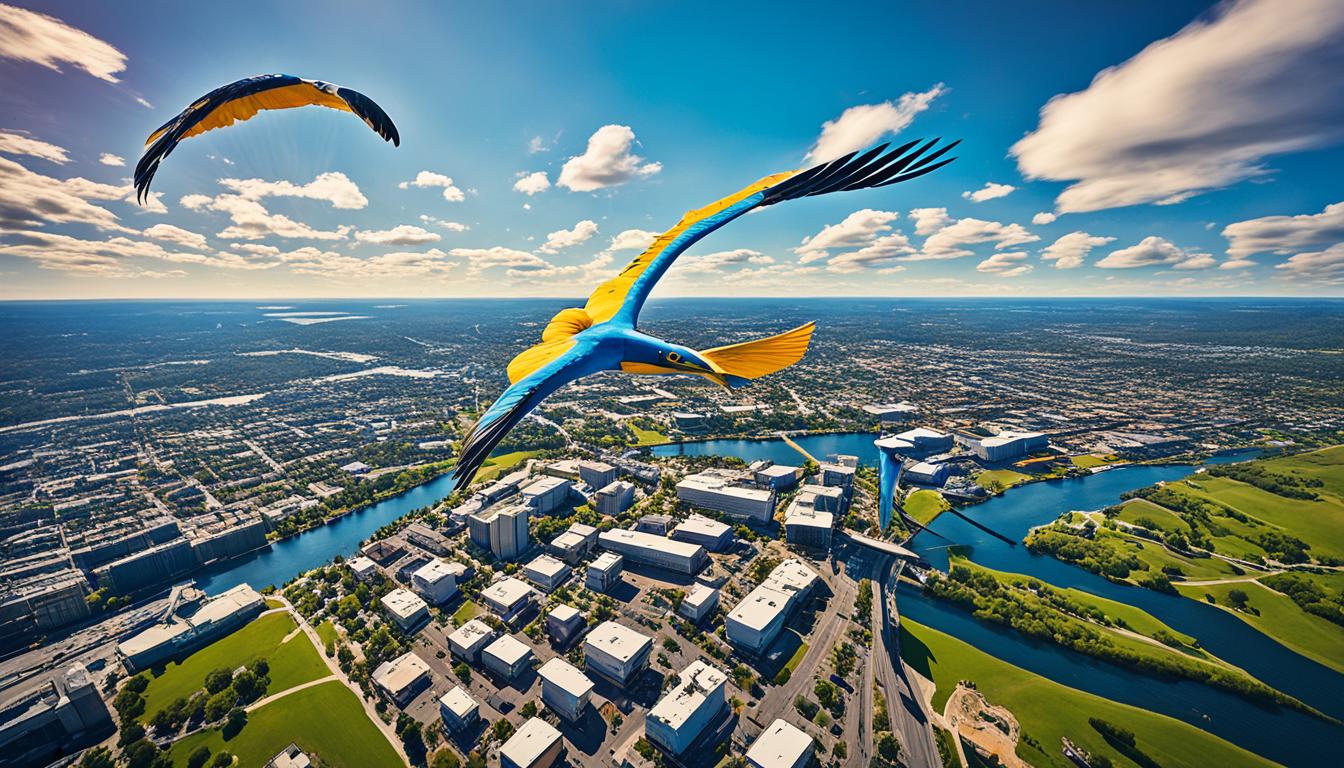Welcome to our comprehensive guide on traveling with drones! Whether you’re a seasoned drone enthusiast or just beginning your aerial adventures, it’s important to know the regulations and best practices for flying drones while traveling. In this article, we’ll provide you with valuable tips and insights to ensure a smooth and enjoyable experience with your drone.
Key Takeaways:
- Research and comply with local drone travel regulations and obtain any necessary permits or approvals.
- Understand the regulations set by the Federal Aviation Administration (FAA) for flying drones in the United States.
- Follow safety guidelines, including maintaining visual line-of-sight, avoiding restricted airspace, and respecting privacy and flying regulations.
- Familiarize yourself with your drone’s features and settings to capture stunning aerial photographs.
- For commercial drone use, obtain a Remote Pilot Certificate and understand any additional restrictions and insurance requirements.
Drone Travel Regulations in the United States
Before you take flight with your drone in the United States, it is crucial to familiarize yourself with the regulations and guidelines set forth by the Federal Aviation Administration (FAA). As responsible travelers and drone enthusiasts, it is our duty to adhere to these rules to ensure the safety of all airspace users.
1. Register Your Drone
One of the first steps you should take as a drone owner is to register your drone with the FAA. If your drone weighs more than 0.55 pounds (250 grams), it must be registered. This process is quick and easy, and it helps the authorities identify the owner in case of any incidents or violations.
2. Keep Your Drone in Sight
During flight, it is essential to maintain visual line-of-sight with your drone at all times. This means you should always be able to see your drone with your naked eye and not rely solely on the camera feed or any other visual aids. Keeping your drone within sight ensures that you can monitor its position and take appropriate actions to avoid any potential hazards.
3. Adhere to Airspace Restrictions
Respecting airspace restrictions is crucial to prevent unauthorized drone flights in sensitive areas. Avoid flying your drone within five miles of an airport or any other location with ongoing aviation operations unless you have obtained prior approval or authorization. It is essential to check for any temporary flight restrictions (TFRs) that may be in place before each flight.
4. Altitude and Speed Limits
Drones should be flown at altitudes below 400 feet above ground level (AGL) and at speeds below 100 miles per hour (mph) unless authorized otherwise. These limits help maintain a safe separation between drones and manned aircraft, ensuring the integrity of the airspace and reducing the risk of collisions.
5. Carry Credentials and Permits
When traveling with your drone, it is advisable to carry your registration certificate and any other necessary permits or credentials required by local authorities. These documents serve as proof of compliance and may be requested by law enforcement or other relevant officials.
“Adhering to drone travel regulations is our responsibility as drone enthusiasts and travelers. By following these guidelines, we can ensure a safe and enjoyable experience for everyone.”
By following these drone travel regulations in the United States, you can fly responsibly and contribute to the positive image of drone enthusiasts. Remember, safety is paramount, and it is our collective duty to promote the responsible use of drones. Now that you are familiar with the regulations, let’s explore international drone travel regulations in the next section.
International Drone Travel Regulations
When it comes to flying drones internationally, it’s crucial to understand and adhere to the specific regulations in each country. Drone laws and restrictions can vary significantly, and failure to comply can result in fines, confiscation of your drone, or even legal consequences. To ensure a smooth and hassle-free experience, we recommend researching the drone travel restrictions and laws of your destination before your trip.
Notable Drone Travel Restrictions
Let’s take a closer look at some notable drone travel restrictions in various countries:
| Country | Drone Travel Restrictions |
|---|---|
| United Kingdom | Drones must be flown below 400 feet and kept within the operator’s line of sight. Flying near airports, military installations, or densely populated areas is strictly prohibited. |
| Australia | Drone operators must register their drones and obtain a Remote Pilot License. Drones cannot be flown within 30 meters of people, over populous areas, or near critical infrastructure. |
| France | Drone flights are restricted in certain areas, including national parks, urban areas, and airports. Operators must obtain authorization from the French Civil Aviation Authority for specific flight locations. |
| Canada | Drone pilots must register their drones and obtain a Pilot Certificate for Advanced Operations. Drones must be flown within visual line of sight and adhere to specific flight rules based on weight and airspace classification. |
These are just a few examples of the drone travel restrictions implemented by different countries. Before your trip, it is crucial to check the specific rules and guidelines set by the aviation authorities or civil aviation agencies of the country you plan to visit.
Obtaining Permits and Approvals
In addition to understanding the drone travel restrictions, it’s important to determine if you need any permits or approvals to fly a drone in your destination country. Some countries require drone operators to obtain permission in advance or register their drones locally. Failure to do so can lead to penalties or grounded flights.
To find out the requirements for your destination, we recommend checking the official government websites or contacting the local aviation authorities. They will provide the most up-to-date information regarding permits, approvals, and any additional restrictions that may apply.
Remember, as responsible drone enthusiasts, it is our duty to adhere to the rules and regulations. By taking the time to research and understand the international drone travel restrictions, we can enjoy our drones while respecting the local laws and preserving the safety and peace of the places we visit.
Drone Photography Tips
To capture stunning drone photographs, there are a few tips that can take your aerial photography to the next level. By familiarizing yourself with the capabilities and settings of your drone camera, you can make the most of its features and produce high-quality shots.
Utilize the GPS and stabilization features of your drone to ensure steady shots and smooth footage. These built-in technologies help compensate for any movement or vibrations, resulting in clearer and more professional-looking images.
Experiment with different angles and perspectives to add a unique touch to your compositions. Aerial photography provides an opportunity to capture breathtaking views that are otherwise impossible to achieve. So, don’t hesitate to explore various angles and find the ones that best showcase the subject or landscape you’re photographing.
Lighting plays a crucial role in photography, and drone photography is no exception. Pay attention to the lighting conditions when planning your aerial shoots. Shooting during the golden hour, which is the first and last hour of sunlight in a day, can create a magical atmosphere with warm and soft lighting that enhances the beauty of your subjects.
Finally, it is essential to respect the privacy and flying regulations of the locations where you are photographing. Always be mindful of your surroundings and ensure that you are not intruding on private property or restricted areas. By following the rules and being considerate, you can enjoy the art of drone photography while maintaining a positive relationship with the community.
By implementing these drone photography techniques, you can capture breathtaking images and showcase the world from a unique perspective.

“Photography is a way of feeling, of touching, of loving. What you have caught on film is captured forever… It remembers little things, long after you have forgotten everything.” – Aaron Siskind
Drone Photography Tips Summary
| Tip | Description |
|---|---|
| Familiarize yourself with drone camera settings | Understand the capabilities and settings of your drone camera. |
| Utilize GPS and stabilization | Make use of the drone’s GPS and stabilization features for steady shots. |
| Experiment with angles | Explore different angles and perspectives to create unique compositions. |
| Shoot during the golden hour | Take advantage of the beautiful lighting conditions during the golden hour. |
| Respect privacy and regulations | Always be considerate of privacy and flying regulations in the areas you photograph. |
Drone Safety Precautions
When it comes to traveling with a drone, safety should always be our top priority. By following essential guidelines and best practices, we can ensure a secure and enjoyable experience. Here are some important drone safety precautions to keep in mind:
- Read the Owner’s Manual: Familiarize yourself with the specific safety features and operating instructions of your drone. Understanding its capabilities and limitations will help you fly responsibly.
- Follow FAA Regulations: Adhere to the regulations set by the Federal Aviation Administration (FAA) to ensure compliance with airspace restrictions, registration requirements, and other guidelines. Stay informed about any updates or changes to these regulations.
- Maintain Visual Line-of-Sight: Always keep your drone within your visual line-of-sight during flight. This helps you maintain control and avoid potential collisions or accidents.
- Avoid Flying over Crowds or Moving Vehicles: To minimize risks, it is crucial to avoid flying your drone over crowded areas or above moving vehicles. This ensures the safety of both people and property.
- Be Mindful of Weather Conditions: Before taking off, check the weather forecast and avoid flying in adverse conditions such as strong winds, heavy rain, or thunderstorms. Unfavorable weather can affect the stability and control of your drone.
- Carry Appropriate Insurance Coverage: Accidents can happen, so it’s essential to have insurance coverage that protects against potential damages caused by your drone. Make sure to check with your insurance provider to ensure adequate coverage for your travels.
By following these drone safety guidelines and best practices, you can fly with confidence, mitigate risks, and contribute to a responsible and enjoyable drone travel experience.
Commercial Drone Use and Restrictions
If you plan to use a drone for commercial purposes, such as aerial photography or videography, there are additional regulations to consider. Commercial drone operators in the United States must obtain a Remote Pilot Certificate from the FAA. This certification ensures that operators have the necessary knowledge and skills to operate drones safely and responsibly.
When hiring a drone operator for your commercial projects, it is important to look for a licensed and insured professional. This will protect you from any potential liability or damages that may occur during drone operations. A licensed drone operator will also be familiar with the local rules and regulations, ensuring compliance with commercial drone use guidelines.
One important restriction to be aware of is the prohibition on flying drones directly over people. This regulation is in place to ensure the safety and privacy of individuals on the ground. By avoiding flying directly over people, you minimize the risk of accidents and maintain a respectful distance.
Additionally, it is crucial to understand the limitations of your homeowner’s insurance policy when it comes to commercial drone use. Most homeowner’s insurance policies do not cover damages caused by drone operations for commercial purposes. It is recommended to obtain a separate liability insurance policy specifically designed for commercial drone use to protect yourself and your business from any potential accidents or damages.
Comparison of Commercial Drone Use Regulations in the United States
| Regulation | FAA Requirement | Restriction |
|---|---|---|
| Remote Pilot Certificate | Obtain a Remote Pilot Certificate to operate a drone commercially | N/A |
| Licensing and Insurance | Hire a licensed and insured drone operator for commercial projects | N/A |
| Prohibition on Flying Over People | Avoid flying directly over people for safety and privacy reasons | Flying in accordance with FAA guidelines |
| Homeowner’s Insurance | Understand the limitations of your homeowner’s insurance policy for commercial drone use | Obtaining a separate liability insurance policy for commercial drone use |
Conclusion
Traveling with drones can be an exhilarating experience, allowing us to capture breathtaking moments from unique angles and perspectives. However, it is crucial to be well-informed about the regulations and guidelines established by the Federal Aviation Administration (FAA) and local authorities.
Prior to embarking on our drone adventure, it is essential to thoroughly research the drone laws of our intended destination. Familiarize ourselves with any specific requirements, obtain permits or approvals if necessary, and adhere to local regulations. This ensures that we can enjoy the full potential of our drone while respecting the laws of the land.
Safety should always be our top priority when operating a drone. We must familiarize ourselves with our drone’s features and capabilities, ensuring we understand how to use them effectively. Adhering to airspace restrictions, maintaining visual line-of-sight, and avoiding flying over crowds or moving vehicles are crucial steps to ensure safe and responsible flying.
By combining careful planning, an understanding of regulations, and a commitment to safety, we can embark on a hassle-free journey with our drones. Let’s embrace this exciting form of photography and videography, bringing to life stunning images and capturing memorable moments that will last a lifetime.
FAQ
Are there any specific regulations for traveling with drones in the United States?
Yes, when traveling with a drone in the United States, it is important to register your drone if it weighs more than 0.55 pounds. You should also keep your drone within your visual line-of-sight during flight and adhere to airspace restrictions. Additionally, drones must not be flown within five miles of an airport without prior notification.
Do different countries have their own drone travel regulations?
Yes, drone regulations vary from country to country. It is important to research and understand the specific rules before traveling with a drone. Some destinations may have restrictions on flying drones in national parks or tourist attractions. It is crucial to familiarize yourself with the laws of the country you plan to visit and obtain any necessary permits or approvals.
What are some tips for capturing stunning drone photographs?
To capture stunning drone photographs, it is important to familiarize yourself with the capabilities and settings of your drone camera. Utilize the drone’s GPS and stabilization features to ensure steady shots. Experiment with different angles and perspectives to create unique compositions. Pay attention to lighting conditions and shoot during the golden hour for optimal results. Finally, remember to respect the privacy and flying regulations of the place you are photographing.
How can I prioritize safety when traveling with a drone?
To prioritize safety when traveling with a drone, always read the owner’s manual and understand the safety features of your drone. Follow FAA regulations and respect airspace restrictions. Maintain visual line-of-sight with your drone during flight and avoid flying over crowds or moving vehicles. Be mindful of weather conditions and avoid flying in adverse weather. Carry appropriate insurance coverage to protect against potential damages caused by the drone.
What do I need to know about using a drone for commercial purposes?
If you plan to use a drone for commercial purposes, such as aerial photography or videography, you must obtain a Remote Pilot Certificate from the FAA in the United States. It is important to hire a licensed and insured drone operator for commercial projects. Be aware of restrictions on flying directly over people and understand the limitations of your homeowner’s insurance policy for any potential damages caused by commercial drone use.
What are some important drone travel tips to keep in mind?
When traveling with drones, it is important to research and understand the regulations set by the FAA and local authorities. Familiarize yourself with the laws of your destination and obtain any necessary permits or approvals. Prioritize safety by understanding your drone’s features, following airspace restrictions, and practicing responsible flying. With careful planning and adherence to regulations, you can enjoy a hassle-free journey and capture amazing drone footage.
What Are the Regulations for Traveling with Drones and Using Them for Photography?
When it comes to drone photography laws compliance, it’s important to be informed about the regulations for traveling with drones. Different countries and regions have varying rules regarding the use of drones for photography. Make sure to research and follow the specific guidelines to ensure a smooth and legal experience.




